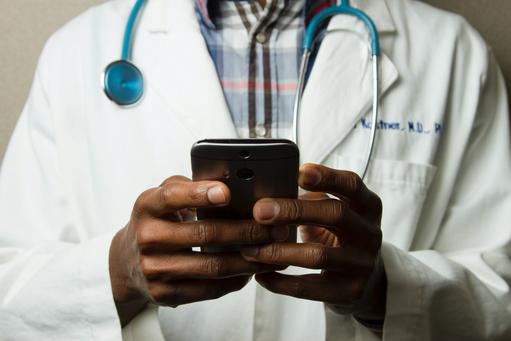|
Cost-effective asset to relieve growing pressure on GPs
Can the escalating primary care crisis in England be helped with a new and innovative online dashboard, which automatically sends short videos contributed by clinicians to patients’ mobiles to address their FAQs?
Dr Seth Rankin, Managing Partner of the Wandsworth Medical Centre, and co-chair of Wandsworth CCG’s diabetes group, who has spearheaded the dashboard, thinks it can. Click on the photo below to view a short video that describes how health professionals can use the dashboard:
New and innovative dashboard
A 24/7 fully automated service that never wears out “ We were motivated to do something about the increasing pressure on GPs, and the impact this has on the quality of our care. Patients may have to wait a couple of days for an appointment with a GP, but they can receive our videos within minutes of their request,” says Rankin. He continues: “A pilot study we carried out in two London primary care practices suggested that video is a patient’s preferred format if they can’t see a GP. Further, patients often don’t retain what you tell them in a 10-minute face-to-face consultation, and they tend not to read pamphlets, which also are expensive to produce. 53% of patients regularly search the Internet for healthcare information, but 81% can’t differentiate between good and bogus information. 72% prefer healthcare information from their GP, and like healthcare videos delivered directly to their mobiles. 70% want access to healthcare information at any time, from anywhere, on their mobiles. “Unlike the Internet, our dashboard provides premium reliable information, which can be easily consumed and shared among family, friends and carers. Also, the videos can be viewed many times, from anywhere, and unlike pamphlets and doctors, they never get tired, never wear out, and are available 24/7, 365 days a year. The dashboard is fully automated [see figure below], relieves GPs of a lot of unnecessary work, and, importantly, reports on how our patients’ are using the different videos.”
 Automated system that encourages engagement behaviours
Local experts
“We used local medical experts in our videos because we were keen to increase their connectivity with our patients. The videos provide 60 to 80 second talking-head answers to patients’ questions, and are designed to increase patients’ knowledge of their condition, propel them towards self-management, slow the onset of complications, and reduce face-time with GPs, while enhancing the quality of our care,” says Rankin.
Diabetes
He continues: “Although the dashboard easily can be used for any disease state, we started with T2DM as it represents our largest group of patients. Also, we know that: (i) T2DM is preventable with effective education that encourages diet and lifestyle changes, (ii) current diabetes education fails, and over the past decade, the incidence rate of the condition has increased by 65%, (iii) only 16% of the 120,000 people diagnosed each year with diabetes in England are offered structured educational courses, and (iv) only 2% of those offered courses actually enrol in them. So, we created our own bespoke dashboard and content library of about 120 videos, which we organised under 10 headings that we know interest our patients. Each heading has a cluster of ‘essential’ and ‘in-depth’ videos. We use the dashboard to relieve some of the pressure on our health professionals.”
Unprecedented crisis
Saturation point
A 2016 study published in The Lancet suggests that between 2007 and 2014 the workload in NHS general practice had increased by 16%, and that it is now reaching saturation point. According to Professor Richard Hobbs of Oxford University and lead author of the study, "For many years, doctors and nurses have reported increasing workloads, but for the first time, we are able to provide objective data that this is indeed the case . . . . . As currently delivered, the system [general practice in England] seems to be approaching saturation point . . . . . Current trends in population growth, low levels of recruitment and the demands of an ageing population with more complex needs will mean consultation rates will continue to rise.”
More than 1m patients visit GP every day
A 2014 Deloitte’s report commissioned by the Royal College of General Practitioners (RCGP) suggests that the GP crisis in England is the result of chronic under-funding and under-investment in primary care at a time when the demand for GP services is increasing as the population is ageing, and there is a higher prevalence of long term conditions and multi-morbidity.
According to the RCGP, over the past five years the number of annual GP consultations has increased by 60 million to around 370 million, while over the same period the number of GPs has grown by only 4.1%. More than one million patients a day visit their GP surgeries, with some GPs now routinely seeing between 40 to 60 patients daily.
GPs are extremely stressed
Deloitte’s findings are confirmed by a 2016 comparative study undertaken by the prestigious Washington DC-based Commonwealth Fund, which concludes that increasing workloads, bureaucracy and the shortest time with patients has led to 59% of NHS GPs finding their work either “extremely” or “very” stressful: significantly higher stress levels than in any other western nation. GP stress levels are likely to increase. In a speech made in June 2015, the UK’s Secretary of Health said, “Within 5 years we will be looking after a million more over-70s. The number of people with three or more long term conditions is set to increase by 50% to nearly three million by 2018. By 2020, nearly 100,000 more people will need to be cared for at home.” According to Dr Maureen Baker, chair of RCGP, “Rising patient demand, excessive bureaucracy, fewer resources, and a chronic shortage of GPs are resulting in worn-out doctors, some of whom are so fatigued that they can no longer guarantee to provide safe care to patients.”
Causes and consequences
GP exodus
Trainee GPs are dwindling and young GPs are moving abroad. According to data from the General Medical Council (GMC), between 2008 and 2014 an average of 2,852 certificates were issued annually to enable British doctors to work abroad. We now have a dangerous situation where there are hundreds of vacancies for GP trainees. Meanwhile, findings from a 2015 British Medical Association (BMA) poll of 15,560 GPs found that 34% of respondents plan to retire in the next five years because of high stress levels, unmanageable workloads, and too little time with patients.
Suggested solutions
5,000 more GPs by 2020
In the run up to the UK’s 2015 General Election the Secretary of Health pledged “to train and retain an extra 5,000 GPs by 2020” to ease the primary care crisis, but doctors’ leaders did not see this as a solution. Dr Maureen Baker said, "Even if we were to get an urgent influx of extra funding and more GPs, we could not turn around the situation [the GP crisis] overnight due to the length of time it takes to train a GP,” And Dr Chaand Nagpaul, chair of the BMA GPs’ committee, warned later that, “delivering 5,000 extra GPs in five years, when training a GP takes 10 years, was a practical impossibility that was never going to be achieved.” After the election the Health Secretary softened his promise and suggested that it would be ‘a maximum' of 5,000 by 2020.
In 2016, Pulse, a publication for GPs, suggested that the Health Secretary knows he cannot deliver his promise of 5,000 new doctors by 2020, and is negotiating with Apollo Hospitals, an Indian hospital chain, to bring 400 Indian GPs to England.
A more innovative approach
Better and smarter solutions needed While searching for an immediate temporary solution to the GP crisis the Secretary of Health seems to understand that a more innovative approach is required for the medium to long term. In his June 2015 speech he said, “If we do not find better, smarter ways to help our growing elderly population remain healthy and independent, our hospitals will be overwhelmed – which is why we need effective, strong and expanding general practice more than ever before in the history of the NHS. Innovation in the workforce skill mix will be vital too in order to make sure GPs are supported in their work by other practitioners.” Pharmacists in GP surgeries In July 2015 the NHS launched a £15m pilot scheme, supported by the RCGP and the Royal Pharmaceutical Society (RPS), to fund, recruit and employ clinical pharmacists in GP surgeries to provide patients with additional support for managing medications and better access to health checks. Dr Maureen Baker said, “ GPs are struggling to cope with unprecedented workloads and patients in some parts of the country are having to wait weeks for a GP appointment yet we have a ‘hidden army’ of highly trained pharmacists who could provide a solution”. Dr David Branford, former Chair of the RPS said, “ It’s a win-win situation . . . . We will be doing everything we can to support the GPs and make sure this pilot is successful. In time, I hope pharmacists will be working in every GP practice in the country.” Ash Soni, president of the RPS suggests that it makes sense for pharmacists to help relieve the pressure on GPs, and says, “ Around 18m GP consultations every year are for minor ailments. Research has shown that minor aliment services provided by pharmacists can provide the same treatment results for patients, but at lower cost than at a GP surgery.” Progressive and helpful move The efficacy for an enhanced role of pharmacists in primary care has already been established in the US, where retail giants such as CVS, Walgreens and Rite Aid have led the charge in providing convenient walk-in clinics staffed by pharmacists and nurse practitioners. Over time, Americans have grown to trust and value their relations with pharmacists, which has significantly increased adherence to medications, and provided GPs more time to devote to more complex cases. Non-adherence is costly, and can lead to increased visits to A&E, unnecessary complications, and sometimes death. According to a New England Healthcare Institute report, Thinking Beyond the Pillbox, failure to take medication correctly, costs the US healthcare system $300 billion annually, and results in 125,000 deaths every year.
Takeaway
Introducing pharmacists into GP surgeries is a progressive and potentially helpful move forward, because, as Dr Maurine Baker suggests, “It is in everyone’s best interests to be seen by a GP who is not stressed or fraught and who can focus on giving their patients the time, attention and energy they need”. However, even more could be achieved if the dashboard described by Dr Seth Rankin were more widely introduced. “Videos play a similar role to practice-based pharmacists. Both deal with simple day-to-day patient questions, and relieve pressure on GPs, which allows them to focus their skills where they are most needed,” says Rankin.
.
|














